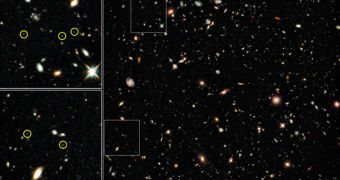The famous Hubble Space Telescope, with its newly installed, advanced scientific components, is now able to look extremely far back into the history of the early Universe, at a time when everything around us was just a fraction of its current age. Such a deep look was taken recently, when the telescope peeked at a time when the Universe was about 700 million years old. This was the age of the earliest galaxies and stars, and the Ultra Deep Field image that was snapped has the potential to clear a number of astronomical mysteries related to the early days of the Cosmos, Space reports.
According to Hubble mission officials, the telescope's maximum capability is to look some 12.9 to 13.1 billion years into the past. In essence, the team is currently pushing the NASA Great Observatory to its limits, in order to get the clearest, most detailed image of the old “establishment” possible. Being this close to the hypothetical Big Bang that might have produced everything around us, astronomers and astrophysicists expect to find a number of peculiar and unexplained events that could provide, in the end, some explanations for some of the most long-standing mysteries about stars, planets and galaxies.
“Essentially we are looking back 13 billion years. We're pushing Hubble to the limits to find these objects,” University of California in Santa Cruz expert Garth Illingworth explained. He made the announcement in Washington DC yesterday, while speaking at the 215th annual meeting of the American Astronomical Society (AAS). The new Ultra Deep Field image was collected over four days of exposure in August, and some of the most interesting aspects of it were presented at the time. At the conference, some of the peculiarities seen in the image received further attention.
The expert team revealed that the galaxies that were clear in the new photo were not the first ones. “The galaxies have primordial-like characteristics. [However], we're not finding primordial galaxies,” Illingworth added at the meeting. He believes that discovering the first galaxies to have ever formed following the Big Bang is an effort that would require a new generation of space-based observatories, such as the upcoming James Webb Space Telescope (JWST). Until that time, astronomers will have to settle with images obtained by Hubble, or similar instruments, and with analyzing some of the earliest galaxies to have ever ignited the darkness that followed the Big Bang.

 14 DAY TRIAL //
14 DAY TRIAL //